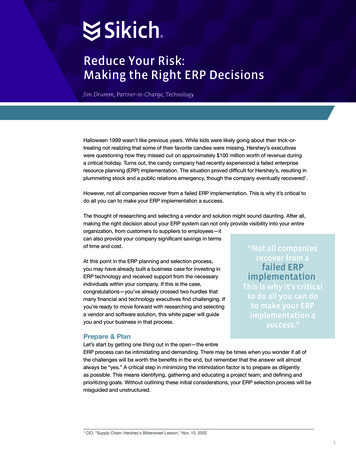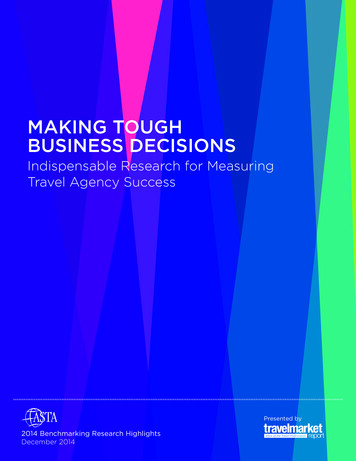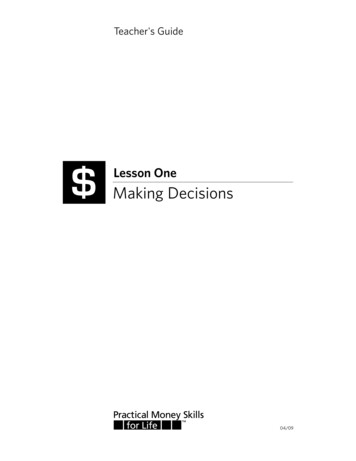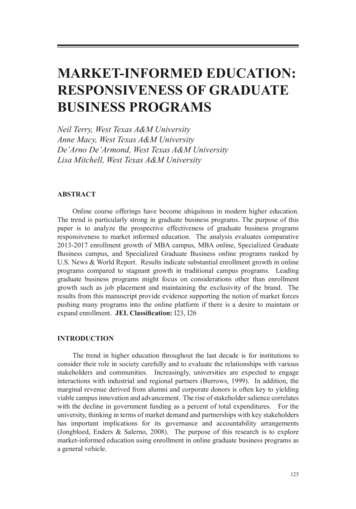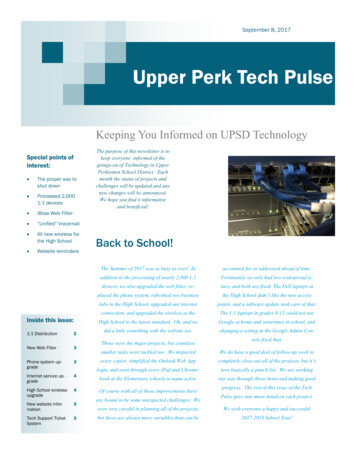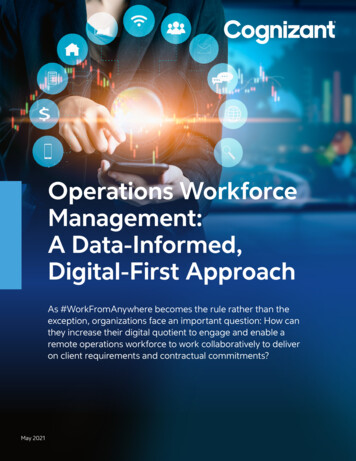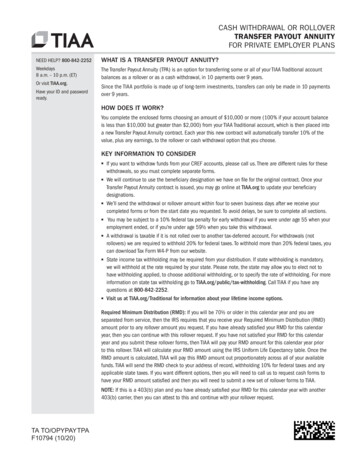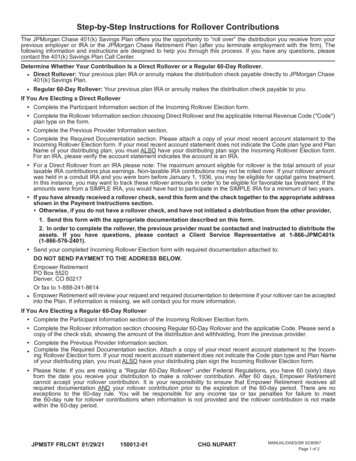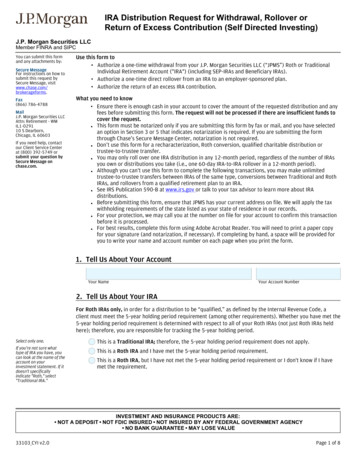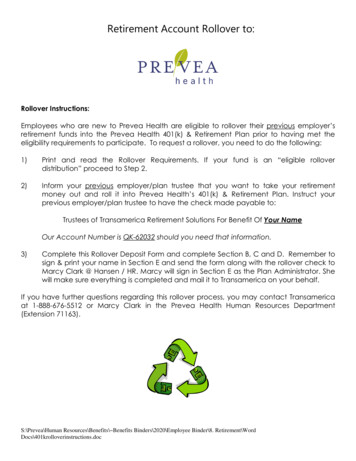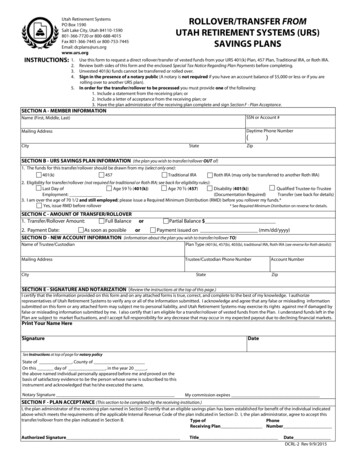
Transcription
Making Informed Rollover DecisionsWhat to do with your employer-sponsored retirement plan assetsDefined Contribution Plans:A defined contribution plan does not promise a specific amount of benefits at retirement. In these plans,the employee or the employer (or both) contribute to the employee’s individual account under the plan.Examples of defined contribution plans include 401(k) plans, 403(b) plans, employee stock ownershipplans and profit sharing plans.Defined Benefit Plans:A traditional defined benefit plan generally promises a guaranteed stream of income payments for yourlifetime. The plan may state this promised benefit as an exact dollar amount, such as 100 per month atretirement, or it may calculate a benefit through a plan formula that considers such factors as salary andservice. A cash balance plan is a type of defined benefit plan.Your optionsRetiring, changing jobs, or otherwise terminating employment presents many decisions that you shouldconsider, one of which is what to do with the assets in your former employer’s 401(k), 403(b), defined benefit orother employer-sponsored qualified retirement plan. Deciding what to do with those assets could be one of themost important financial decisions you will make. In particular, you may be able to:¡ Stay in your former employer’s plan¡ Roll over to your new employer’s plan¡ Directly roll over to an Individual Retirement Account (IRA)1¡ Take a lump-sum distributionQuestions to consider:– Have you joined a new company that has an employer-sponsored qualified retirement plan?– If yes, does this new plan accept rollovers?INVESTMENT AND INSURANCE PRODUCTS ARE: NOT FDIC INSURED NOT INSURED BY ANY FEDERAL GOVERNMENT AGENCY NOT A DEPOSIT OROTHER OBLIGATION OF, OR GUARANTEED BY, JPMORGAN CHASE BANK, N.A. OR ANY OF ITS AFFILIATES SUBJECT TO INVESTMENT RISKS, INCLUDING POSSIBLE LOSS OF THE PRINCIPAL AMOUNT INVESTED1
Taking a lump-sum distributionUnless you have an immediate financial need, taking a lump-sum distribution from your employer’s plan maynot be the best option for you. You will be subject to ordinary income tax—including a 20% mandatory federalincome tax withholding—in the year in which you receive the distribution, and if you are under age 59½ a 10%penalty tax may also apply. Additionally, your retirement assets will no longer continue to grow on a tax-deferredbasis, unless you elect to roll them over within 60 days (also known as an indirect rollover2). Speak with your taxadvisor if you are considering an indirect rollover.There are many factors that could influence which options may be best foryou. The decision you make today can have long-term implications.Understanding your optionsThere are many factors that could influence which of the options may be best for you and it is important tounderstand the advantages and disadvantages involved with each choice. The decision you make today can havelong-term implications. Here are some of the factors you should consider.¡ Investment ChoicesIf the investment choices offered in your current or future employer plan meet your needs, then you shouldconsider staying in your current employer‘s plan or rolling over the balance to your future employer‘s plan. Someemployer plans may also offer access to managed accounts or self-directed brokerage accounts that providethe opportunity for broader diversification. Many plans also offer target date funds that strategically shift assetallocations over time, generally using a combination of equity, fixed income and money market funds. Targetdate funds become more conservative as the target retirement date approaches (e.g., a young investor lookingto retire in 2050 would select a target date 2050 fund). Target date funds tend to be a low-cost, diversifiedinvestment option.If having access to a wider range of investments—including individual stocks and bonds, mutual funds andmanaged accounts—is important to you and such investments are not available in your current or futureemployer’s plan, an IRA may be a better option.Questions to consider:– Am I satisfied with the investment options available in my current or future employer’s plan?– Does my plan allow for easy reallocation as I near retirement and/or my goals change?– Am I invested in a target date fund(s)?– Would an IRA offer additional investment options that are important to me?2
Special Considerations for Plans Offering Guaranteed Income PaymentsIf one or more of the employer-sponsored qualified retirement plans available to you offers a guaranteedstream of income payments for your lifetime (e.g., a defined benefit pension plan), you should take special carewhen considering your distribution options. You might be nearing retirement age and considering what to dowith your accrued benefits under a defined benefit plan. Or, maybe your former employer has offered you aspecial buyout offer of your pension plan benefits. Selecting the right payment option is important because theoption you choose can affect the benefits you receive.Generally, plans such as a defined benefit pension plan guarantee a specific payout upon retirement. Manyplans also provide payment options which distribute benefits to your beneficiaries after your death. Paymentoptions commonly include:¡A single life annuity that provides a fixed monthly benefit until death,¡A qualified joint and survivor annuity that provides a fixed monthly benefit until death and allows yoursurviving spouse (or another beneficiary) to continue to receive benefits until his or her death, or¡The entire value of your accrued benefit paid as a lump sum distribution.If you decide to roll over assets from a defined benefit plan (or other plan that provides a guaranteed incomestream) to an IRA, remember that you will be giving up the guaranteed income stream available to you underthe plan and may be assuming market risk with respect to those assets. This may make sense for you if youbelieve your expenses in retirement will primarily be satisfied by sources other than the income stream underyour plan and, as a result you are comfortable in assuming market risk with respect to the assets you roll over.Questions to consider:– Is it important to me to have a guaranteed monthly income check in retirement?– If I decide to take a lump sum distribution and roll that over to an IRA, will I be able to grow that amountsufficiently to generate my desired monthly income in retirement?– Am I comfortable with taking on market risk with respect to assets which would have funded a guaranteedincome stream?– Do I have enough guaranteed monthly income to cover my basic living expenses without the payments fromthe plan?¡ Access to Additional Financial ServicesSome employer plans offer access to varying levels of investment advice, planning tools, telephone help lines,educational materials and workshops. Similarly, IRA providers may also offer various financial services, includinginvestment advice from a Financial Advisor, distribution planning and goals-based financial planning.Questions to consider:– What financial services are available in my employer’s plan and how satisfied am I with them?– Is the convenience of having all of my retirement savings consolidated at one financial institution importantto me?– Is having a Financial Advisor who can provide advice with regard to my retirement investments importantto me?3
Knowing that you can take advantage of the loan provision in your newemployer’s plan (if available) may be important to you.¡ Ability to Take Loans and WithdrawalsMany employer-sponsored qualified retirement plans allow for loans to be taken against your vested accountbalance. In contrast, taking loans from an IRA is not allowed. Knowing that you can take advantage of the loanprovision in your new employer’s plan (if available3) may be important to you. If so, you should think aboutrolling over to your new employer’s plan. Remember to first ask your new employer if future contributionswill be restricted if you take a loan. Also keep in mind that all outstanding loan balances not repaid when youultimately leave your employer will likely be treated as a taxable distribution and may also be subject to the10% penalty tax. Consider whether you have funds available to pay back the loan—either directly to the plan(if eligible) or by adding the outstanding amount of the loan to the assets you are rolling over to an IRA. Andremember to speak with your tax advisor for additional information.Instead of taking a loan, you may find the financial need to withdraw funds directly from your employer plan orIRA. When it comes to withdrawals, please note the following significant differences between an employer’s planand an IRA:TREATMENT OF WITHDRAWALS FROM AN EMPLOYER PLAN VS. AN IRASTAY IN FORMER EMPLOYER’S PLANOR ROLL OVER TO NEWEMPLOYER’S PLANROLL OVER TO IRATaxation of withdrawalsWithdrawals will generally be subject totaxation at ordinary income rates.Withdrawals will generally be subjectto taxation at ordinary income rates.Early withdrawal penalties 4Withdrawals before age 59½ may be subjectto a 10% penalty tax (unless you terminateemployment with the plan sponsor on orafter age 55 or another exception applies)Withdrawals before age 59½ may besubject to a 10% penalty tax (unlessan exception applies)Distribution optionsEmployer plans may offer more limiteddistribution optionsIRAs offer flexible distributionoptions, including the ability torequest withdrawals at any timeand to establish regularly scheduledsystematic paymentsQuestions to consider:– Is it important to have the ability to borrow from my retirement assets?– Did I terminate (or do I expect to terminate) employment between ages 55 and 59½?– When do I plan to begin taking withdrawals?– What amount do I plan to take?– Will I require systematic retirement distributions and, if so, at what frequency? Is a specific payment dateimportant to me?– Do I want the ability to access my retirement assets if an unexpected need arises?– Do I need immediate access to any of the assets in my employer-sponsored qualified retirement plan?– Does my current or new employer’s qualified retirement plan allow for in-service withdrawals.4
¡ Taking Required Minimum DistributionsWhen you turn the age specified by the IRS, as further described below, you must begin taking RequiredMinimum Distributions (RMDs) from employer plans and IRAs, subject to the following exceptions:- If you are working and participating in the qualified retirement plan where you work, you do not have to takeany RMD from that plan until the year after you retire (unless you are a “5% owner” of the business or theplan otherwise requires)- Roth IRA owners are not required to take RMDs (but, after the account owner’s death, beneficiaries of alltypes of IRAs, including Roth IRAs, are subject to required minimum distribution rules)5Effective January 1, 2020, the IRS RMD age changed from 70½ to 72. However, individuals who turned 70½on or before December 31, 2019 still have an IRS RMD age of 70½ and are not able to take advantage of thedeferred RMD age.“It is important for you to carefully review and compare the fees andexpenses associated with your available options.”¡ Fees and ExpensesFees and expenses can erode the value of your retirement savings over time. It is important for you to carefullyreview and compare the fees and expenses associated with your available options.Depending on the plan type, employer plans may include administrative fees (e.g., recordkeeping, compliance,trustee fees) and fees for services such as access to a customer service representative. In some cases,employers pay some or all of the plan’s administrative fees, and plans may have lower fees and expenses thanare available in an IRA. The plan may also offer no-load mutual funds and institutional share classes that havelower investment-related expenses than similar investments available in an IRA. Ask your employer or humanresources department for a copy of the plan’s 404(a)(5) participant fee disclosure or other available documentthat outlines the fees and expenses you may incur in your 401(k) or other employer-sponsored retirement plan.IRA providers may charge annual account fees or other fees for maintaining your IRA, and the investmentsoffered may include a sales charge at purchase and may have higher internal expenses than the investments inan employer plan.Questions to consider:– How do the fees and expenses associated with my employer’s plan compare with IRA fees and expenses?– Am I getting a good value for the services that matter to me?5
¡ Protection from Creditors and Legal JudgmentsIf you currently have, or anticipate having, a need to protect your retirement assets from creditors or legaljudgments, you need to know what protection is afforded to employer plans and IRAs. Generally, assets held inyour employer’s plan will have unlimited protection from creditors while IRAs may be protected in bankruptcyproceedings only and, even then, potentially only up to a certain dollar amount. State laws vary regarding theprotection of IRA assets in lawsuits. Be sure you consult with an attorney for more information on protectingyour retirement assets from creditors or legal judgments.Questions to consider:– Will I need to protect my retirement assets from creditors or legal judgments?¡ TaxesWhether you keep your retirement assets in an employer-sponsored qualified retirement plan or roll themover to an IRA, in most cases they will continue to grow on a tax-deferred basis until they are withdrawn. If youremployer‘s plan allowed after tax contributions, they may be eligible for rollover to a Roth IRA.6 You may want todiscuss the nuances of this strategy further with your tax or legal advisor.Special Considerations for Employer Stock: If your employer-sponsored qualified retirement plan accountincludes appreciated employer stock, there is a unique option you should take into account when assessingyour options.The Net Unrealized Appreciation or NUA strategy refers to the utilization of a specialized tax treatment whendistributing employer stock as part of a “lump sum distribution” 7 from such a plan. NUA refers to the differencein value between the cost basis of the employer stock (i.e., what you paid for the stock) and its current marketvalue. The NUA tax treatment will be determined based on whether the employer stock was purchased usingpre-tax or after-tax contributions. This discussion assumes that the employer stock was purchased with pretax contributions.If you elect to utilize the NUA strategy, the employer stock is distributed in-kind to your taxable non-retirementaccount; the balance of your non-employer stock assets in your plan account can be similarly distributed orthey may be rolled over to the plan of a successor employer or an IRA which will accept such assets. WithNUA tax treatment, the cost basis of the employer stock is taxed at your ordinary income rate in the year ofthe distribution from the employer’s plan, and an additional early withdrawal penalty tax4 may apply if youare under age 59½. However, if you elect to utilize the NUA strategy the appreciation on your employer stockholdings at the date of distribution is taxable at the long-term capital gains tax rate when you ultimately sell thestock; and any additional appreciation thereafter is taxable at the applicable short- or long-term capital gainstax rate (depending on the holding period) when the stock is subsequently sold. The capital gains tax rates8 aregenerally lower than applicable ordinary income tax rates.6
NUA Example – AssumptionsEmployer stock cost basisBased on the forementioned assumptions, you would pay ordinary income tax on the 10,000 costbasis ( 10 per share times 1,000 shares).Net unrealized appreciationThe Net Unrealized Appreciation of 40 per share ( 50/share FMV minus 10/share cost basis) wouldbe recognized as a long-term capital gain upon sale of the stock.Post distribution earningsAny additional gain above the fair market value of 50 per share would be a short-term capital gainif the shares were sold within one year of when you received them or a long-term capital gain if theshares were sold after holding them for one year.The NUA illustration displayed is hypothetical in nature and does not reflect actual investment results orguarantees of future results. There are many factors which will affect whether the NUA strategy is appropriatefor you: pre- and post-distribution growth rates, capital gains tax rates, ordinary income tax rates and thepotential need to diversify, to name a few. Furthermore, elections regarding your employer stock to eitherutilize the NUA strategy or roll over to an IRA or the plan of a successor employer are often irrevocable. Inparticular, if you roll employer stock over to an IRA, it is no longer eligible for NUA tax treatment and any gainswill be taxed at ordinary income tax rates when distributions are taken from the IRA. In this regard, pleasenote that JPMorgan Chase & Co. and its affiliates do not provide legal, tax, or accounting advice. Before makingdecisions with legal, tax, or accounting ramifications, you should consult appropriate professionals for advicespecific to your situation.¡ Other ConsiderationsBeneficiary Designations: As you are working through the options available to you, also be sure to givesome thought to who you want to receive your retirement assets upon your death. Most employer-sponsoredqualified retirement plans only allow for a spouse to be named as beneficiary if you are married unless yourspouse agrees to let you name a non-spouse beneficiary(ies). IRAs generally provide more flexibility when itcomes to beneficiary designations.Be sure to talk with your tax advisor about the effect of state laws pertaining to community property andbeneficiary designations.IRA-to-IRA Transfers: If you have an IRA(s) at another financial institution, you may want to considerconsolidating your IRAs at J.P.Morgan by completing an IRA to-IRA Transfer.If you are considering a transfer you will want to take into account some of the items discussed in this brochureincluding fees and your desire to obtain personalized investment advice and guidance from a J.P. MorganAdvisor.Whether you invest independently, or work with a J.P. Morgan Advisor, you should determine whether you’re ontrack to meet your goals and look at your retirement plans holistically.7
1Under a direct rollover, assets distributed from an employer-sponsored qualified retirement plan (e.g., 401(k), 403(b) or 457(b) account) arepayable directly to the receiving IRA custodian/trustee, for the benefit of the participant.2With an indirect rollover, the assets are distributed to the participant/employee, who has 60 days after the date of receipt to roll over thedistributed funds to an IRA or eligible retirement plan. Rollovers of assets from an employer-sponsored qualified retirement plan are not subjectto the same restrictions as IRA-to-IRA rollovers (i.e., IRA-to-IRA rollovers are limited to one every 12 months).3Loans, if available from your current or future employer‘s plan, are limited to 50% of your vested account balance up to a maximum of 50,000.4Please refer to the IRS chart on penalty tax exceptions utions.5Please refer to the IRS website for rules pertaining to Required Minimum Distributions: tributions-rmds Because of the complexity of these rules, the extensive changes made byrecent legislation (especially with respect to IRAs established by beneficiaries (“inherited IRAs”)) and the potential tax implications for individualcircumstances, you should consult with a tax or legal advisor concerning any RMD questions you may have.6Please refer to IRS website https://www.irs.gov/retirement-plans/r
Making Informed Rollover Decisions What to do with your employer-sponsored retirement plan assets Your options Retiring, changing jobs, or otherwise terminating employment presents many decisions that you should consider, one of which is what to do with the assets in
